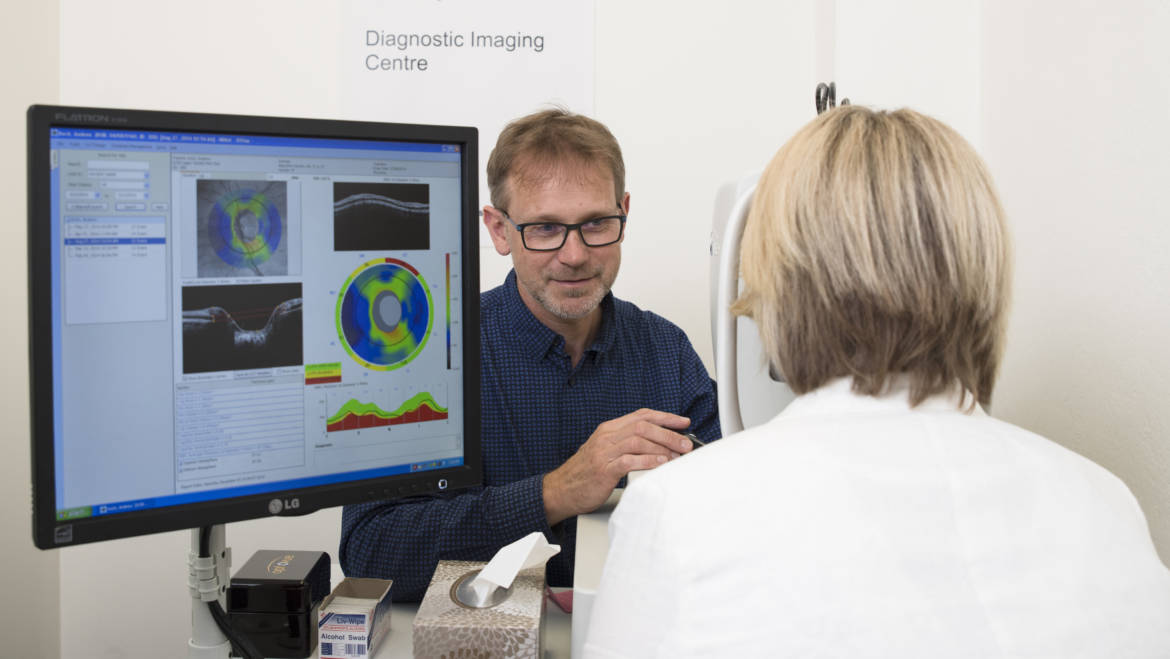
The human eye provides the only window into your body’s blood vessels without having to cut you open. Because of this, your optometrist will often detect a variety of health conditions using our cutting edge technology and testing equipment. And early detection can mean a better outcome for you.
Diabetic eye examinations
Diabetes can affect the delicate blood vessels at the back of the eyes. Diabetic eye disease is the most common cause of low vision and blindness amongst working aged people. It is important that any diabetic have their eyes regularly examined. At diagnosis and then 1-2 yearly for Type 1 and Type 2 diabetics. A diabetic eye examination involves dilating the pupil of the eye with drops and carefully examining all structures of the eye, especially for the retina, for damage, and digital imaging for documentation. Your eyes will be photographed and an OCT scan of the back of your eye may be recommended. We will then develop a management plan to reduce the risk of development or progression of eye disease and communicate with your GP, and refer to an ophthalmologist if significant diabetic eye disease is present which may reduce your vision.
Glaucoma screening
Glaucoma is a common eye disease, affecting about 3% of the population over 40 years of age, and getting much more common the further away you are from 40. It can happen in younger patients, even children, though this is rare.
Glaucoma is a disease that affects your optic nerve, this is the nerve that connects your eye to your brain and allows you to see. In early stages of glaucoma, your optic nerve become can become damaged with no symptoms that you would notice. Eventually, it progressively reduces your side vision and can cause blindness. If you have symptoms from glaucoma (eg, feeling that your side vision is not as good as it should be, or often bumping into things or having trouble judging distances in your car) then it is probably quite advanced. Don’t wait, early detection is vital.
The cause of damage to your optic nerve is that it cannot cope with the level of pressure inside your eye. For a lot of people, there are no symptoms of high eye pressure. A comprehensive check for glaucoma involves looking at your optic nerve, both clinically and often with a scan of your optic nerve with an OCT, as well a check of your eye pressure. A side vision test (automated visual field test) may also be recommended.
Every person over 40 should be screened for glaucoma every 2 years, or more regularly if you have risk factors for glaucoma, such as having a family member with glaucoma.
Macular degeneration screening
Age related Macular Degeneration is the most common cause of blindness and low vision in Australia. The risk of developing macular degeneration goes up over the age of 50. Macular Degeneration causes blurred or distorted vision in the centre of your vision and can reduce people’s ability to read and see faces.
Screening for Macular Degeneration involves checking how clear your vision is and checking whether there is any distortion in your vision. We will also look at your macula at the back of your eye to look for early signs and take digital images to record your level. A supplementary OCT scan of your macular may be recommended for monitoring and diagnosis.
Macular degeneration comes in 2 types: wet and dry. The wet form can be very aggressive but there is an effective treatment. The dry form tends to be much slower but there is currently no definitive treatment. Your optometrist may recommend a dietary supplement that has been shown in large clinical trials to slow the progression of Macular Degeneration.